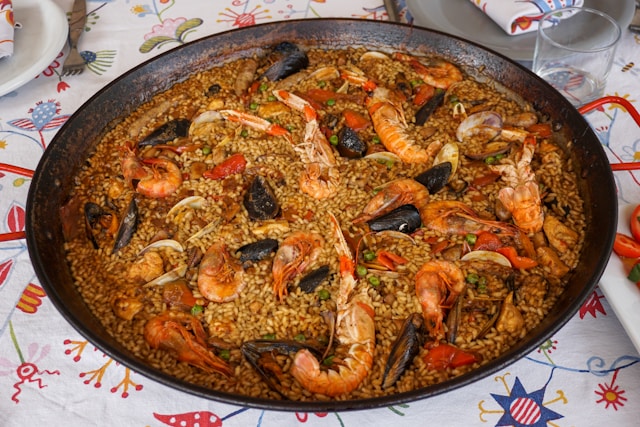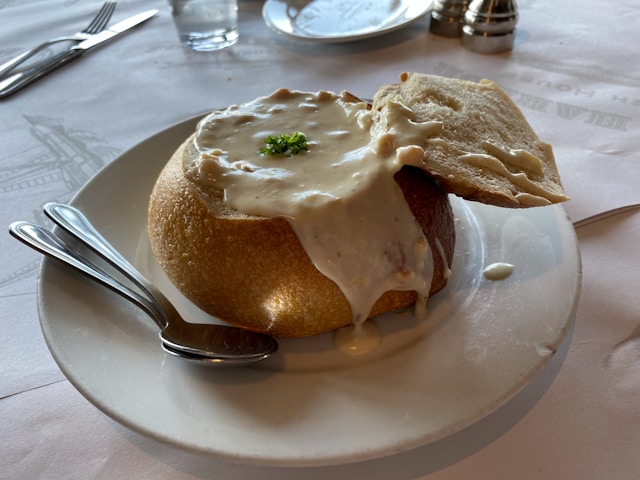Table of Contents:
- Key Takeaways
- Introduction to Clam Chowder
- Ingredients and Variations
- The Art of Making Clam Chowder
- Clam Chowder Across Cultures
- The Role of Clam Chowder in Festivals and Events
- Sustainable Seafood and Clam Chowder
- Clam Chowder as Comfort Food
- Pairing Clam Chowder with Other Foods and Beverages
- Clam Chowder in Contemporary Cuisine
- Closing Thoughts on the Enduring Love for Clam Chowder
Key Takeaways:
- Clam chowder encapsulates the spirit of American coastal cuisine with its diverse regional variations and hearty flavors.
- Homemade chowder bridges the simple pleasure of cooking and the complex interplay of flavors rooted in history.
- Sustainable seafood practices ensure that the tradition of chowder continues environmentally responsibly.
- Celebrating the community aspect of clam chowder through festivals and events highlights its cultural importance.
As a beloved dish celebrated across the nation, clam chowder encapsulates more than just the essence of seafood in a bowl. It embodies a rich history, nutritional value, and the comforting hug of warm, savory flavors. The dish brims with a cultural tapestry that dates back centuries, finding its roots along the cragged coastline of New England and weaving its way over to the iconic piers of San Francisco, where tantalizing variations such as the best clam chowder in Fisherman’s Wharf continue to draw in both locals and tourists alike.
Ingredients and Variations
At the heart of any clam chowder lies a delicate harmony of rustic potatoes, fragrant vegetables, and, of course, the star ingredient: clams. Whether enveloped in a milk or cream base or enlivened by a zesty tomato blend, these fundamental elements vary from region to region, each with its narrative. The rich and robust New England clam chowder has practically become synonymous with chowder itself. Yet, other areas offer enticing tomato-based and apparent broth variations, respectively.
Exploring how locally sourced seafood contributes to the broth’s complexity is intriguing. Assertions that the finest chowder is crafted solely from the freshest, locally procured clams are well-founded. Particularly when searching for the best clam chowder in Fisherman’s Wharf, the salty sweetness of the clams, along with notes of thyme, bay leaf, and a whiff of bacon or salt pork, may take anyone to the misty shores where these clams were picked.
The Art of Making Clam Chowder
Making an exquisite pot of clam chowder is akin to conducting a symphony – each ingredient must play its part at the right moment to create a harmonious final product. The process often begins with rendering the fat from bacon or pork to provide a savory depth to the foundation. From there, onions and other vegetables are softened, and flour is introduced to form a roux that will give the chowder its signature body. When the base has reached the perfect consistency, stock and cream are gradually added, followed by the clams, which should be cooked just long enough to tenderize.
The attentiveness to detail doesn’t end in the pot. Presenting the chowder is also an art form – a steaming bowl, brimming with the bounties of the sea and garden, can be garnished with a sprinkle of fresh herbs or served with a side of crisp oyster crackers. The rich aroma entices the senses, promising a delicious and heartwarming meal.
Clam Chowder Across Cultures
The malleability of clam chowder’s base recipe has permitted it to cross cultural boundaries, transforming fluidly in intriguing ways. The Portuguese, for example, add linguiça for a smoky note, and in the American South, a splash of sherry might make an appearance for an added layer of complexity.
These cultural spin-offs have prompted global chefs to embrace clam chowder as a template for culinary creativity. Whether it’s the addition of spices like coriander and cumin or the fusion of other shellfish such as mussels or crab, chowder continues to evolve, making it a cosmopolitan citizen of the world. Though perhaps unorthodox, each iteration reveres the original by bringing new fans to the chowder-loving table.
The Role of Clam Chowder in Festivals and Events
The legacy of clam chowder is joyfully celebrated through festivals and competitions that dot the coastal landscape. Iconic events like the Newport Great Chowder Cook-Off have become pilgrimage sites for enthusiasts eager to savor modern interpretations and time-honored recipes. These festivals showcase the unity of communities and the shared passion for a dish that has become so much more than just comfort food – it’s a cultural icon.
Such celebrations are a dance of delicate flavors and pride, an opportunity for professional chefs and amateur cooks to receive accolades for their culinary artistry. These spirited exchanges are about winning, preserving, and passing on the chowder tradition.
Sustainable Seafood and Clam Chowder
Because the essence of clam chowder is intertwined with the oceans’ offerings, the importance of marine conservation has become ever more relevant. Ethical and sustainable harvesting practices for clams and seafood are not optional – they are necessities for the health of our environment and the preservation of food cultures tied to these marine resources. It is heartening to see that the clam chowder community, from individual enthusiasts to large restaurants, has embraced the initiative to source seafood sustainably, ensuring that the oceans continue to thrive and provide for future chowder connoisseurs.
Ensuring the harmonious balance between enjoying a beloved dish like clam chowder and caring for our oceans recommends visiting resources like Seafood Watch, which provides invaluable guidance on making environmentally sound seafood choices.
Clam Chowder as Comfort Food
Whether it’s the cold snap of winter or the need for a soothing dish, clam chowder stands unparalleled as a comfort food. It’s not just the creamy, velvety texture or warmth it brings but also the memories that simmer with the chowder. The nostalgia of family get-togethers, with ladles of chowder, served onto steaming plates, often transcends the culinary experience and builds a memorable emotional connection with this homely dish.
For those who have grown up with it, clam chowder represents tradition and the enduring presence of the sea in their lives. For others, it might be their first foray into a tradition rich with history and flavor. In either case, the dish stands as a beacon of American culinary heritage, touted for its remarkable ability to evoke comfort and satisfy even the most refined palates.
Pairing Clam Chowder with Other Foods and Beverages
The nuances in a well-crafted chowder call for thoughtfully selected accompaniments. Crusty artisan bread makes a classic pairing, perfect for sopping up the flavorful broth, while light and lemony arugula salad can offer a crisp contrast to the soup’s creaminess. In terms of libations, to stand up to the robustness of the dish, a buttery Chardonnay or a crisp Pilsner can enhance its rich flavor while cleaning the palate.
For those with avant-garde tastes, clam chowder could become part of a tasting menu, paired with a smoky Scotch, or even incorporated into a seafood risotto cake, challenging the conventional paradigms. In this sense, understanding complementary flavor profiles and textures brings out a more panoramic culinary adventure.

Clam Chowder in Contemporary Cuisine
Today’s kitchens see clam chowder as a bearer of tradition while still ripe for innovation. Sophisticated eating establishments might deconstruct the chowder, reconstructing it with gastronomic techniques that redefine its presentation and taste. Elsewhere, new creations inspired by chowder find their place on menus, such as savory chowder-stuffed pastries or seafood lasagna with a creamy, chowder-like béchamel.
The bold flavors of clam chowder are now interpreted freely, crossing culinary borders and pushing into new territories. This resurgence instills excitement and rekindles the spirit of discovery amongst chefs, enthusiasts, and diners alike.
Closing Thoughts on the Enduring Love for Clam Chowder
As we set our spoons down, it’s clear that our journey through the story of clam chowder is as rich and satisfying as the dish itself. The enduring love for this classic soup is rooted deeply in its ties to tradition, community spirit, and the ability to adapt and transform with each kitchen it graces.
Ultimately, clam chowder is more than just a culinary dish; it is a shared experience, a memory-soaked comfort, and a testament to America’s diverse food culture. As we continue to celebrate and preserve its history, every bowl offers a warm invitation to discover its layers of flavors. For ongoing insights and stories from the world of clam chowder, keep an eye on resourceful platforms such as the New York Times Food Section, which keeps the conversation alive with fresh perspectives and trends shaping our gastronomic landscapes.
Featured Photo by Kevin Lanceplaine on Unsplash
